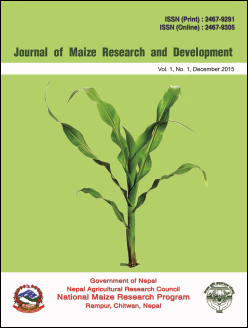Tillage and planting density affect the performance of maize hybrids in Chitwan, Nepal
DOI:
https://doi.org/10.3126/jmrd.v1i1.14240Keywords:
Tillage, density, affect, maize, hybridsAbstract
To find out whether the different tillage methods at different planting densities affect the performance of maize hybrids, an experiment was carried out at National Maize Research Program, Rampur during spring season of 2013 and 2014. The experiment was laid out in strip plot design with three replications having 12 treatments. The vertical factor was tillage with conservation tillage (No Tillage + residue=NT) and conventional tillage (CT) and the horizontal factor were genotypes (Rampur Hybrid-2 and RML-32/RML-17) and in split planting geometries (75cm × 25cm =53333 plants/ha, 70cm × 25cm=57142 plant/ha and 60cm ×25cm= 66666 plants/ha). In both the years, the highest number of cobs (73,177 and 67638/ha) was recorded at planting density of 66666/ha. NT had the highest no of kernel rows/cob (14.01) as against 12.12 in CT in 2014. The highest number of kernels (27.3 and 29.29) per row was recorded in NT during 2013 and 2014 respectively. Similarly, in 2014, the highest number of kernels were found in RML-32/RMl-17 (29.17/row) and planting density of 53333/ha (28.46/row). In 2013, RML-32/RML-17 produced the highest test weight of 363.94g over the Rampur hybrid-2 with 362.17g. Significantly the highest grain yield of 9240.00 kg/ha in 2013 and 7459.80 kg/ha in 2014 at planting geometry of 65cm ×25cm were recorded. No effects was found by tillage methods for grain yields of maize in 2013, but was found in 2014 (7012.18 kg in NT compared to 6037.59 kg/ha in CT). NT and wider spaced crop matured earlier in both the years; however Rampur hybrid-2 matured earlier to RML-32/RML-17 in 2013. In 2014, harvest index of 47.85 % was recorded in planting geometry of 66666/ha, the highest benefit cost ratio of 1.36 was worked out in NT and 1.46 at the density of 66666/ha. The highest value of 2.46% of soil organic matter was recorded in NT as compared to 2.43% in CT.
Journal of Maize Research and Development (2015) 1(1):10-20
DOI: http://dx.doi.org/10.5281/zenodo.34285




